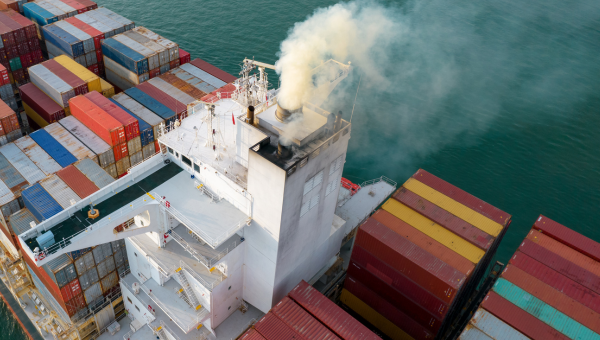Update on decarbonisation issues for shipping, October 2023
This is a busy period for new regulation coming on-line which impacts on shipping and the usual way of conducting business.
Two regulations have come into force during 2023 from the international regulator, the International Maritime Organisation. Additionally, maritime is to be added to the existing EU Emissions trading scheme, which imposes a cost on creating Greenhouse Gas (‘GHG’) emissions within the EU.
IMO Regulations
The IMO’s Initial Strategy for decarbonising shipping has introduced a number of new regulations, among them the Ship Energy Efficiency Management Plan (‘SEEMP’), the Energy Efficient Existing Ship Index (‘EEXI’) and Carbon Intensity Indicator (‘CII’).
These are in force and require ship owners to develop and execute plans for the energy efficient use of vessel, take steps to ensure vessels meet the Required EEXI and are traded in an energy efficient manner. The regulations are aimed at reducing the impact of shipping on the environment through the adoption of energy efficiency measures, effectively slowing down shipping.
This is giving rise to challenges reflective of both the commercial and contractual context in which shipping operates.
EEXI
The EEXI Regulation applies to existing vessels (newbuilding are already regulated by EEDI) of and over 400 gross tonnes and requires existing vessels to achieve a target level of energy efficiency (the Required EEXI). Where a vessel does not achieve the Required EEXI, owners must take corrective action. In practice, the necessary corrective action has generally been to limit the vessel’s achievable speed through applying engine limitations (EPL)/ shaft power limitation systems (SHAPOLI).
Although it has proved to be uncontroversial that the time and cost of a vessel undergoing EPL or SHAPOLI falls to the vessel owner, more controversial is how the performance of the newly limited engine is to be assessed for the purpose of speed and consumption warranties.
Bimco’s EEXI Transition Clause for Time Charterparties 2021, where adopted into charterparties, provides (amongst other things) that where there has been EPL or SHAPOLI work then the vessel description will be logically amended and for any change in performance and consumption to be within performance curve for the vessel based on the existing warranted figures. The clause also provides that charterers will not order the vessel to proceed at a speed exceeding the maximum speed.
Where the Bimco EEXI Transition Clause has not been accepted or the charterparty is silent on EEXI, issues arise particularly concerning deviations from performance warranties as a consequence of owners complying with the EEXI obligations.
CII
The implementation of the CII regulation and how it is to be treated in a charterparty context has so far proved difficult. CII will produce a rating per vessel of A-E (where A is the most efficient and E the least) with a compliance benchmark of C. Penalties are written into the regulation for vessels achieving below C.
The structure of the CII regulation is to take account of the vessel’s physical and operational state for the purpose of calculating the applicable rating. One of the more broadly applicable controversies of the calculation so far is the impact the operational aspects of a vessel have on the CII. For the most part and under most charterparty contracts, operations are one of the key commercial rights of the charterers i.e. to determine where the vessel trades to, what is carried and at which speed.
Bimco has published two clauses so far to assist commercial parties in negotiating charterparty clauses relevant to CII: the CII Operations Clause for Time Charter Parties 2022; and the CII Clause for Voyage Charter Parties 2023. Bimco also stresses the importance of the parties co-operating in order to smooth implementation of the regulation.
The Bimco CII Operations Clause for Time Charter Parties 2022 is an involved clause which has not been popular with many chartering entities. The main objections to the clause include the rights given to owners to refuse to follow charterers’ orders and to reduce the vessel speed, although these arise in the specific circumstances provided for in the clause and the right for owners to claim in respect of various heads of loss for a breach by charterers of the clause. As a consequence, commercial parties have been negotiating clauses which generally provide for close co-operation and future agreement. Such clauses, if in a contract governed by English law, should be treated with care since, if they are purely ‘agreement to agree’ in nature, they will have limited (if any) enforceability.
The Bimco CII Clause for Voyage Charter Parties 2023 has recently been released, such that it is too soon to comment on market reaction. The clause focuses on the parties agreeing the vessel’s speed in good weather conditions and a minimum speed while giving owners/the master rights to adjust course or reduce speed within those set parameters, with a view to maintaining CII compliance for the vessel.
Addition of Maritime to EU Emissions Trading Scheme
On 5 June 2023, amendments to the existing EU Emissions Trading Directive came into force, extending the EU Emissions Trading Scheme (EU ETS) to shipping as of 1 January 2024.
EU ETS in shipping
In brief the EU ETS works on the ‘cap and trade’ principle. A cap is a limit set on the total amount of greenhouse gases that can be emitted and is reduced annually in line with the EU’s climate goal of reducing emissions over time. The cap is expressed in emission allowances, where one allowance gives the right to emit one tonne of CO2eq (carbon dioxide equivalent) and companies surrender allowances to account for their emissions. Allowances can be bought on the EU carbon market and can also be traded as needed.
In the shipping context, a cap will be set on the total amount of GHGs that may be emitted in the EU in an annual period and the cap is reduced over time.
Who needs to comply?
The focus for compliance is the ‘Shipping Company’ who is liable to surrender allowances in respect of emissions within the scope of the EU ETS. ‘Shipping Company’ is defined as:
“shipping company means the shipowner or any other organisation or person, such as the manager or the bareboat charterer, that has assumed the responsibility for the operation of the ship from the shipowner and that, on assuming such responsibility, has agreed to take over all the duties and responsibilities imposed by the International Management Code for the Safe Operation of Ships and for Pollution Prevention, set out in Annex I to Regulation (EC) No 336/2006 of the European Parliament and of the Council [the ISM Code].”
By default the Shipping Company will be the registered owner of the vessel, unless compliance with the ISM Code has been delegated to another entity which is named in the ship’s Document of Compliance and Safety Management Certificate e.g. bareboat charterer, manager.
As compliance will be assessed on a company-wide (rather than per ship) basis, it must be ensured across the fleet.
However, the “polluter pays” principle means that the Shipping Company can recover compliance costs from the entity that is ultimately responsible for purchasing the fuel and/or operating the ship.
Member States are encouraged to implement measures into domestic legislation to ensure that these costs are passed down (Article 3gc) which provides:
“Member States shall take the necessary measures to ensure that when the ultimate responsibility for the purchase of the fuel, or the operation of the ship, or both, is assumed by an entity other than the shipping company pursuant to a contractual arrangement, the shipping company is entitled to reimbursement from that entity for the costs arising from surrender of the allowances.
‘Operation of the ship’ for the purposes of this Article means determining the cargo carried or the route and speed of the ship.[…]”
The Article provides expressly that the compliance obligation on the shipping company will not be lessened and guidance to the Member States is that parties are not to be permitted to circumvent the entitlement to the shipping company to obtain reimbursement through choice of law clauses. This could give rise to the question of whether, when seeking reimbursement, the shipping company has to bring that claim in a Member State or whether it is able to do so under charterparty clauses which deal with the EU ETS as well as how those positions can be reconciled without breaching any charterparty law and jurisdiction clause and/or the law of a Member State implementing the EU ETS.
Who will enforce?
Enforcement will be carried out by the ‘Administering Authority’ which shall be:
in the case of a shipping company registered in a Member State, the Member State in which the shipping company is registered;
in the case of a shipping company that is not registered in a Member State, the Member State with the greatest estimated number of port calls from voyages performed by that shipping company in the last four monitoring years and falling within the scope set out in Article 3ga;
- in the case of a shipping company that is not registered in a Member State and that did not carry out any voyage falling within the scope set out in Article 3ga in the preceding four monitoring years, the Member State where a ship of the shipping company has started its first voyage falling within the scope set out in that Article.”
What is the scope of the EU ETS for Maritime?
Which vessels?
Pursuant to revised Article 2 and Annex I of the ETS Directive, and revised Articles 2 & 3 of the MRV Regulation, the EU ETS will apply to:
ships above 5,000 gross tonnage, but excluding warships, naval auxiliaries, fish-catching or fish-processing ships, wooden ships of a primitive build, ships not propelled by mechanical means, or government ships used for non-commercial purposes;
performing voyages arriving at or departing from the EU or between EU ports of call;
a port of call being “a port where the ship stops to load or unload cargo or to embark or disembark passengers, or the port where an offshore ship stops to relieve the crew,” pursuant to Article 3(z) ETS Directive. That Article also sets out exclusions to the definition of port of call, including “stops of containerships in a neighbouring container transhipment port listed in the implementing act adopted pursuant to Article 3ga(2)”. According to Article 3ga(2) of the revised ETS Directive, that list shall be established by 31 December 2023 and updated every two years. Those will be ports within 300 nm of an EU port and where 65% of the port container traffic is transhipment (unless the country of the port has a corresponding ETS in place);
- greenhouse gas emissions released into the atmosphere by those ships on those voyages, and produced by those ships whilst in EU ports, being, pursuant to Annex I of the revised ETS Directive, carbon dioxide emissions in 2024 and 2025 and from and including 1 January 2026 carbon dioxide, methane and nitrous oxide.
What emissions?
Under Article 3ga(1) of the ETS Directive, but subject to the phase in detailed below, it will be mandatory to surrender allowances covering:
50% of the verified emissions for voyages which enter or depart the EU;
- 100% of the verified emissions for voyages between ports in the EU and produced by ships at berth in a port within the EU.
The EU Emissions Trading System is intended to work in conjunction with the EU MRV (monitoring, reporting and verification) Directive, which entered into force on 1 July 2015. This provides for the monitoring, regulation and verification of CO2 from ships arriving at, within or departing from EU ports and/or European Economic Area ports.
Phase-in
Under Article 3gb of the revised ETS Directive, shipping companies shall be liable to surrender allowances in respect of carbon dioxide emissions as follows:
40 % of verified emissions reported for 2024 (i.e. 20% of verified emissions for voyages into or out of the EU);
70 % of verified emissions reported for 2025 (i.e. 35% of verified emissions for voyages into or out of the EU);
100 % of verified emissions reported for 2026 and each year thereafter (i.e. 50% of verified emissions for voyages into or out of the EU); and
- From and including 2026 allowances in respect of 100% of verified emissions of methane and nitrous oxide emissions (i.e. 50% of the total verified emissions for voyages into or out of the EU) must also be surrendered.
Availability of allowances
The EU wide allowances for maritime will be 79 million but this will reduce year on year by 4.2%. There is no proposal to allow for the free allocation of allowances to shipping companies and it presently appears these will be issued at auction only.
Any entity can hold allowances and these are to be recorded in the Union Registry. Allowances will be valid indefinitely, but cannot be surrendered against emissions produced in earlier (non-marine) phases of the ETS.
Penalties
The ETS Directive requires Member States to implement rules on penalties applicable to infringement in national law. The Directive requires Members States to:
publish the names of shipping companies that are in breach of their obligations to surrender allowances.
makes shipping companies which do not surrender allowances, as obliged by 30 September in the following year, liable to pay an excess emissions penalty of EUR 100 for each tonne of carbon dioxide emitted beyond the allowances surrendered. The shipping company must also surrender allowances in respect of those excess emissions when submitting allowances for the following year. Pursuant to Article 16(4), the penalty of EUR 100 is index linked and subject to increases.
without prejudice to the rules applicable where a ship is in distress, where a shipping company has failed to comply with the obligation to surrender allowances for two or more consecutive years, the competent authority of the Member State of the port of entry may issue an expulsion order to that shipping company, and all Member States except the flag state (if a Member State) shall refuse entry of the ships of that shipping company to any of their ports until the shipping company fulfils its obligations.
- Where a ship of the shipping company enters or is found within the flag state (if a Member State) the Member State shall detain the ship until the shipping company fulfils its obligations. The Member State shall inform the EU Commission, EMSA and other States of the detention order and those States shall take the same measures as following the issue of an expulsion order, i.e. shall deny the ships of the shipping company entry to their ports.
Why is this relevant?
The addition of maritime to the EU ETS will impose a new cost on shipping which takes place in the EU.
As with the EEXI and CII regulations, Bimco have released an ETS Emissions Trading Scheme Allowances Clause for Time Charterparties. This deals with emissions trading schemes generally (and so is of wider application than the EU scheme).
Again Bimco emphasises the importance of cooperation between the contracting parties and also identifies the party responsible for fuel as being responsible for the emissions trading allowances. The owners, for their part, are to monitor and report the ship emissions data, forming as it does the basis for the calculation of the applicable allowances.
Although there many ways in which suitable clauses can be drafted, the suitability of any particular clause will depend on a number of commercial factors.
In particular, the following questions are all highly relevant to the decision of which clause to use (whether a BIMCO clause or a bespoke version): who will be acquiring the allowances; how they will be acquired (all in one go at the beginning of each auction year, spread out during the year, at the end of each auction year/ prior to the date for surrender); how to calculate the allowances/frequency of calculation; how to share data to enable verification of the calculation; and whether a commercial shipmanager is involved and if so, whether this is a service they can offer (with any necessary amendments to the management contract).
Decarbonisation issues and in particular those highlighted in this article are novel. They impact on traditional relationships and give rise to many fresh challenges which often require specific legal advice.
We are grateful to Beth Bradley and Reema Shour of Hill Dickinson for this article. Please see more articles below.




